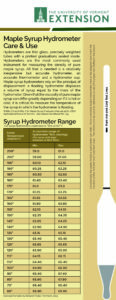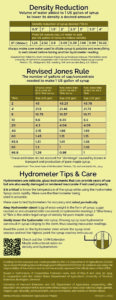Search Resources
Showing 1 – 10 of all 713 resources in the database
Syrup yields not equal across all operation sizes
Generally, the data suggests that the larger maple operations will realize higher average yields than operations with fewer taps.
An Initial Assessment of the Frequency of Maple Crop Failure in the U.S.
Some seasons sometimes produce a bountiful crop of maple syrup. In other years producers are considerably less lucky. Periodic failures of the maple crop happen.
Effects of the January 1998 Ice Storm on Stem and Root Carbohydrate Reserves, Radial Growth and Tree Vigor in Two Vermont Sugarbushes
The ice storm of January 1998 damaged well over 17 million acres of forest in the northeast, including nearly 1 million acres of forests in Vermont (Figure 1, Miller-Weeks and Eagar 1999, Vermont Department of Forests, Parks & Recreation 2000). Many of the areas which experienced damage were active sugarbushes, with severe damage to tubing systems in affected zones.
Characterizing maple sap flows
Individual sap flow events are highly variable and dynamic, ranging from slow, weeping flows that last for days to short bursts of high flow that last for only a few hours.
Bark removal and taphole closure with arc-barb spouts
The Arc-Barb Spout (UVM Patent Pending) is designed with a shortened barrel to allow improved sap flow from the shallower, more productive sapwood zones in maple stems.
Drop and spout sanitation review
Considerable research has been conducted by the Cornell Maple Program and University of Vermont Proctor Maple Research Center on the effects of spout and tubing sanitation on improvements in sap yield and economics.
Maple Research & Outreach Professional Profiles “Dr. Tim” Perkins
Tim Perkins was born and raised in the Northeast Kingdom of Vermont. As a youth, he, along with his seven siblings (5 brothers, 2 sisters) and father, helped on their grandfather’s (and later Uncle’s) farm in Westmore, Vermont. His chores included gathering sap from buckets, carrying firewood, and, of course, tasting syrup.
Ask Proctor: Tiny Bubbles
Maple producers using tubing often observe bubbles emerging from the tree within the spout or first few inches of tubing when the sap is running. If the spout is not seated properly, leaks may occur.T hese are most noticeable as rapidly moving streams of small or large bubbles. At other times, these are not leaks, however repeated or overly aggressive attempts at seating spouts to make the bubbles stop can create leaks that further attempts at spout seating will only make worse.
Temperature Compensation Chart for Maple Syrup Hydrometers
The University of Vermont Extension’s “New” temperature compensation chart syrup hydrometers. 

